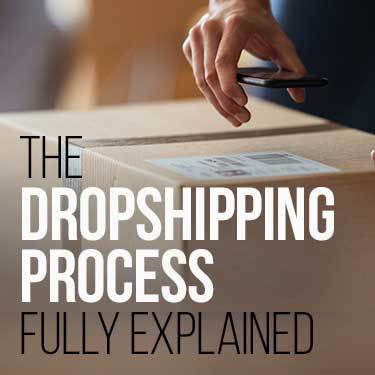
 Copy URL to Clipboard
Copy URL to Clipboard
If you’ve ever thought about the possibility of starting your own business, then you’ve probably heard about the dropshipping process before. The online business model that requires very little upfront investment is causing quite a stir in the entrepreneurial space. The concept might seem overwhelming if you don’t know much about it, but it’s not as complicated as it seems! With a little explanation, you can understand the dropshipping process and get on your way to starting your own online business!
The dropshipping process is as follows:
While the process above may seem simple and concise, there’s much more going on behind the scenes that makes dropshipping happen. Our comprehensive guide below provides you with a complete understanding of the dropshipping process.
Table of Contents

Before you move on, it’s important for you to familiarize yourself with these terms.
Supply chain: This describes the entire process of turning raw materials into products and shipping them to customers. If a company is part of the supply chain, it is either a manufacturer, supplier, distributor, wholesaler, retailer, or something else that deals with the creation or movement of goods.
Supplier: A supplier is a person or entity that provides goods, raw materials, or services to other entities in the supply chain. There are often many levels of suppliers. For example, a company may get raw iron from their supplier in the mines. Then, they manufacture that into steel and supply it to another company to turn into car parts. That manufacturer then supplies those car parts to a car manufacturer. That car manufacturer then supplies the finished cars to a dealership, where they are finally sold to the end-user. Each one of those companies is a supplier to the companies that use what they produce.
Entrepreneur: An entrepreneur is a person who takes on the responsibility of starting their own business alone. They often take risks in order to succeed and owe their success to no one but themselves.
Merchant: A merchant resells products manufactured by other companies directly to consumers, rather than for resale. Merchants are also known as dealers, traders, or retailers.
Vendor: A vendor is a person or company that is offering something they made for sale, typically keeping their product lineup rather limited or specific to one area, such as an ice cream vendor, an office supplies vendor, or a clothing vendor. Vendors are typically suppliers for larger retail stores like Target or Walmart that sell a large variety of items but do not manufacture their own goods.
Wholesaler: Wholesale suppliers sell large quantities of goods at relatively low prices to individuals and companies who are not the end-users of the products. Wholesalers ship to restaurants, retailers, and other business users for the purposes of resale or commercial use.
Producer: A producer is a person or company that manufactures, grows, or harvests goods to sell.
Distributor: A distributor is an agent or company that supplies other companies with goods for resale. They can be wholesalers, but they aren’t always. In many cases, manufacturers will give one distributor the sole rights to distribute that particular product, so anyone who wishes to purchase that product must go through the same distributor.
eCommerce: eCommerce means “electronic commerce,” and it describes the process of selling goods online. To learn more about this, check out our article What is Ecommerce Fulfillment?
It might surprise you to know that “drop shipper” isn’t a real title. Dropshipping is a process that involves many people, like manufacturers, distributors, and merchants, so there is no single person who earns the title of “drop shipper.”
Dropshipping is often described as the easiest way to make money online, but what exactly is it, and what do you need to know before you get started?
To put it simply, dropshipping is the process of selling goods online by shipping customers their orders directly from the supplier. Merchants find products that already exist, and develop a marketing strategy to sell those products on their platform. In this way, the merchant works as a middle-man to find more customers for the supplier—while taking a cut of the profits along the way. The supplier benefits from having more customers, and the merchant benefits from being able to earn money on their online store with little to no overhead costs.
The dropshipping process doesn’t require the merchant to ever come into contact with the product they are selling, since the products go directly from the supplier to the customer. Unlike with traditional retailers, there’s no need to worry about keeping stock of inventory, shipping costs, or anything like that. All the merchant has to do is make the sale. This simplifies the process of selling online, and makes it much more alluring to entrepreneurs and people looking to earn supplemental income outside of their regular job.
With all that said, however, you should be realistic with your expectations. Many savvy internet gurus tout dropshipping as some sort of get-rich-quick scheme, but it’s actually not that simple. It’s true that dropshipping is the easiest way to sell online, but that doesn’t mean it is easy. Like any business, running a dropshipping business requires a lot of careful planning and hard work.
Interested in dropshipping? Check out our article on Amazon FBA vs. Dropshipping.
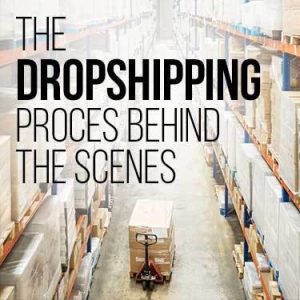
Although dropshipping accounts for almost 33% of all online stores, it is usually impossible to tell which online stores utilize dropshipping and which ones keep their own inventory. Behind the scenes, however, the process looks much different from a typical supply chain.
When a customer orders a product from a dropshipping company, integrated software on the company’s website automatically confirms the purchase and immediately sends a confirmation email to that customer. At the same time, it sends out another email to alert the merchant of the sale. The merchant receives the money for the sale automatically as well.
The merchant must then review the order, and forward the order information to the supplier. Along with that, the merchant must also pay the supplier for the price of the item and the cost to ship it. Then, the supplier will pack the item in a box that is labeled with the merchant’s branding, so the customer will see the brand they recognize on the box. The supplier then ships the box directly from their warehouse to the customer. Depending on the agreement between the merchant and the supplier, the supplier may send an invoice to the merchant after fulfilling the order instead of requiring payment upfront.
Finally, the customer receives their purchase with no indication of it ever coming from anywhere but the merchant they purchased it from. Throughout the product’s entire journey, the merchant never had to come into contact with it even once.
In a traditional supply chain model, goods would be shipped to the merchant first, and then shipped to customers from the merchant’s storage. By cutting out that step in the middle, overall shipping costs can be reduced since each box only needs to be shipped once.
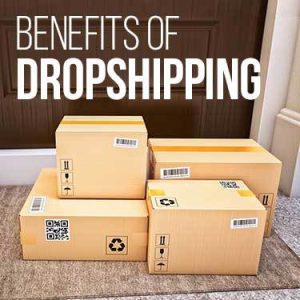
Nowadays, many dropshipping companies are started by first-time business owners and aspiring entrepreneurs. This is because of the many benefits that this business model provides.
The biggest benefit is definitely the low startup costs. When starting a dropshipping business, you won’t have to worry about buying products to stock, storage costs, or setting up a physical location to conduct business. Since your store exists solely online, and the products get shipped straight from your supplier to your customer, you wouldn’t need to worry about most of the costs often associated with starting a business.
Another important benefit to this kind of business model is the flexibility it allows. Dropshipping doesn’t require a lot of continuous attention, and it doesn’t take much time to keep the business operating.
Because of this, people are able to work full-time jobs and manage an entire dropshipping business on the side. Alternatively, someone could run a dropshipping business instead of working a full-time job, and have more time to focus on their hobbies.
To show how much money you will end up spending when you start a dropshipping business, we’ve created a table below
| Task | Cost |
| Obtaining and Keeping A Domain Name | $10-$20 Annually |
| Running An Online Store | $35 Monthly |
| Advertising Online | $500-$600 |
| Cost To Hire Someone to Build Your Website | $130-$260 |
Due to these costs, it’s a good idea to save up at least $1,000 dollars before starting your dropshipping business. This might seem like a lot, but it’s much less than the cost to start other types of businesses. Additionally, you can make this amount back when your dropshipping store starts to take off.
In addition to that, dropshipping businesses are easy to scale up. Since you only have to worry about one aspect of your business, you would be able to scale up much faster and more efficiently than if you had to manage all the different aspects of the business yourself. With dropshipping, you wouldn’t even need to hire employees to help you manage the company—unless you wanted to.
Dropshipping is extremely easy to maintain. If you have everything automated with integrated software, your business could continue to operate long-term with little intervention on your part. You could have all orders automatically forward to your supplier, pay invoices automatically, and even have a bot to respond to customer queries. This would make it easier for you to take impromptu vacations or take a day off here and there with little consequence to your business.
In short, dropshipping allows you to run a real, legitimate business at a fraction of the cost and effort of other online business models.
Lastly, when utilizing dropshipping, you won’t have to pay for managing a warehouse. Dropshipping operations can be run from anywhere, including from the comfort of your own home. As your business grows, you should consider hiring a 3PL to help with your fulfillment needs.
While hiring a 3PL might cost you more, you won’t need to utilize one until your business is making enough profits and has enough volume to require the help. If you find that you do need the assistance of a 3PL, R+L Global Logistics can help you with your needs.
Although dropshipping has many benefits, you should be aware of some of the downsides that can result from using it. Here are some of the challenges you might face with a dropshipping business.
Many businesses like to customize orders for their customers. They do this by sending special gifts or using personalized wrapping. Some businesses prefer to use cardboard boxes with their names on them when they ship an order.
Unfortunately, you won’t be able to do this when using dropshipping. Since the supplier is the one shipping the order, you won’t be permitted to customize the package yourself with any of these features.
In addition to not being able to customize your orders, suppliers might also make mistakes when they ship products. These mistakes could be anything from shipping products late or sending products that are damaged. When these mistakes happen, your customers will hold you accountable rather than the supplier.That is because your customers won’t realize that your supplier ships the product they ordered, not you.
By now, you might be wondering just how you can get started with a dropshipping business of your own. Thankfully, the process isn’t as difficult or intimidating as you’re expecting it to be, as long as you break the process down into actionable steps. It isn’t really different from starting an eCommerce business of any type.
The first thing you’re going to need to do to start your own dropshipping business is to decide what kind of products you want to sell. You’ll need to make sure the products you stock your store with are high-quality; after all, the products themselves will represent you and your business. However, a lot goes into finding a good product to sell—especially if you don’t have any ideas to start with.
Now, when you’re first getting started, it can be really tempting to jump on whatever the newest trend is, but you should be really cautious about trends. Take fidget spinners, for example. Back in 2017, these spinning toys saw explosive popularity, and entrepreneurs all jumped on the chance to stock up on them for their stores.
To find a good product to sell, a good place to start is to think about what interests you. If you have any hobbies, think about the kind of equipment you use. If you play football, for example, you would need a ball, a mouth guard, a helmet, and many other pieces of equipment. If you’re a painter, you know you need to buy paint, brushes, canvases, palettes, and much more. Any one of those items could work, but it’s important to remember that this stage in the process is just for coming up with ideas.
Once you have some ideas, you need to narrow it down until you have one or two types of products. You can, of course, expand your store to include many different items, but you should start small if you’ve never done this before. Here are some tips for eliminating products from your list of ideas.
If you decide to grow your product line later on, you should try to find products that relate to the ones you are already selling. If you’re selling soaps and bath scrubs, you could add things like lotions or balms to your website. If you sell keyboards and mouse pads, you could expand your product line by finding other office supplies to dropship. If you only sell a random collection of products that don’t fit into a similar theme, you may lose some credibility with potential customers.
As we’ve already noted, there are many other dropshipping businesses that you will have to compete with. Taking the time to study how your competitors conduct their operations can give you an advantage.
Not only can you learn from the mistakes of your competitors, but you can also learn from what they do right. Browsing aspects of their business like their prices, website and presence on social media can give you insight into how to conduct your operations.
Once you have decided what you want to sell, you have to find a supplier. One of the most popular options for sourcing dropshipping products is through the massive online marketplace, AliExpress. AliExpress is tremendously popular for several reasons. For one thing, many of their sellers already understand that buyers are looking to resell their goods, especially with dropshipping. Because of that, it is much easier to find suppliers who already offer dropshipping options.
With that said, AliExpress is the most popular option, which means that each supplier is already likely supplying its products to many different sellers. To find products that are more unique, you may have to look elsewhere. Some alternatives to AliExpress for dropshipping include DHGate, DX, and Lightinthebox.
If you decide to search for a supplier outside of a large marketplace like those listed above, you should be extremely cautious about scams. Once you find a supplier, make sure you look for information on them, including how many shipments or sales they have made, what their reviews are, and whether or not they avoid answering any of your questions.
Remember that not all suppliers are going to offer dropshipping services. You need to reach out to each potential supplier to make sure they clearly understand your expectations.
Creating a website might seem like a daunting task, but there is a variety of software available that can make the process easy. For example, sites like Wix and Weebly allow you to create a website online for free, and they’re easy to use! You can simply drag and drop assets onto the screen to build the front-end of your website easily. However, there are drawbacks to these types of website builders: they tend to be slow, it can be difficult to create consistent branding across the site, and not all the functionality is going to be actually free.
Another option for creating a website is through the open-source software offered by WordPress. It’s more difficult to use than a website builder, but it will allow you more freedom and creativity on your website. It also integrates well with many plug-ins that make eCommerce easier, such as WooCommerce.
However you decide to create your website, there are a few things you’re going to need to keep in mind to ensure the best customer experience. Here are the most important elements to an eCommerce store:
While we provide a brief overview of launching your dropshipping business, check out our full article on How to Start a Dropshipping Business for even more information.
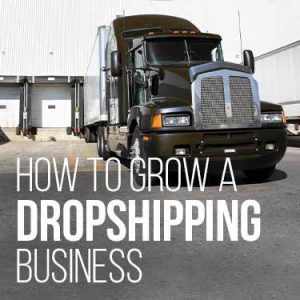
Once you have a dropshipping business set up, you’ll quickly get tired of seeing only a few sales every now and again. If you really want your business to take off (and continue growing), you need to start advertising!
Advertising is at the heart of all successful dropshipping companies, but if you’ve never done something like this before, it can be overwhelming. There are many different ways to advertise an online store, and you may end up using all of them, a few of them, or only one! If you find something that works for you, your product, and your business model, then you should put all your energy into that instead of diluting your attention over multiple different advertising channels.
Here are some advertising ideas to get you started:
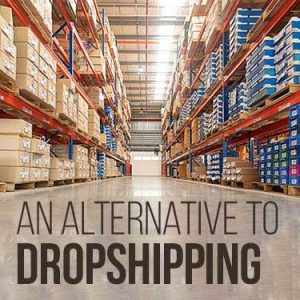
Dropshipping is a great way to get started with a business if you don’t have a lot of money. However, you may decide to change your business model later on, or you may decide that dropshipping was never in line with your goals for your company. Either way, if you’re looking for alternatives, one idea may stick out to you more than others.
Most of the disadvantages associated with dropshipping involves the lack of control that business owners get over their supplier’s inventory. So, many of those problems could be eliminated by managing your own inventory. Buying products at wholesale prices and fulfilling them yourself is more expensive upfront, but you would be able to make much more profit on each sale. You can cut shipping costs, offer more personalized shopping experiences for your customers, and ensure the quality of each item that gets shipped out. You may even be able to continue getting your products from the same supplier, and just save money by making bulk orders instead.
Managing your own inventory can be a challenge. You’ll need to have a solid understanding of demand planning, inventory management, and order fulfillment strategies in order to ensure your success. There are more upfront costs, and mistakes can have larger consequences for your business. More reward comes with more risk, after all. But… What if there was a way to get the best of both options: both the convenience of dropshipping and the profits of managing your own inventory?
If you take control of your own inventory, you will have a new opportunity to help you manage online orders and fulfillment: a Third Party Logistics (3PL) Warehouse. 3PLs offer you the same convenience as dropshipping, since you wouldn’t need to worry about storing goods or shipping the products yourself, but with many more perks. Your customers could enjoy more customization and shorter shipping times, while you can reap the rewards of having a personalized contract with a competitive fulfillment company. This will save you money and free up your time to continue expanding your business.
R+L Global Logistics is a leader in the warehousing and fulfillment industry. We offer competitive pricing and outstanding customer care, so you can just relax and let the pros take care of everything. We’ll treat your business with the care and efficiency that it deserves, so you can rest easy knowing your inventory is in good hands.
In addition to the standard fulfillment process, we also offer a range of value-added services that you can’t get with the dropshipping process. These services are:
When you’re ready to break away from the dropshipping process and start managing your own inventory, turn to R+L Global Logistics to be your trusted partner. You can request a quote online, or reach out to us at (866) 989-3082 for more information today!
